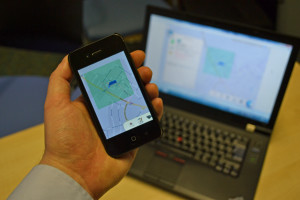September 17th, 2013 by Admin
Payments
“Geofencing” a program that uses the global positioning system (GPS) or radio frequency identification (RFID) to define geographical bounderies. It creates the opportunities for new business models and generations. Allowing the use of mobile tools and services to not only interact with loyal customers, but also reach potentially new customers when they come into a geographic proximity, explained by a spokesperson from a Mobile and Wireless Group. So it does open the doors to some interesting new applications.
To date, radio positioning signals have been supplied to consumers primarily by the U.S. Military through a constellation called “GPS” or Global Positioning System. Essentially, receivers on the ground…. or in cars….interpret the signals and tell you roughly where you are.
Europe’s Galileo global satellite navigation system is expected to open up a variety of business opportunities. Big changes are in the air as a result of new more accurate systems on the way. One example: geofencing, a highly targeted form of tight, perimeter-based locating.
Galileo
A form of geofencing using the U.S. GPS is already used to monitor stolen vehicles, trucks and delivery drivers, among other things. GPS isn’t particularly accurate, though. With more accuracy, geofencing could be used to create a zone around a store or school, for example…or even a particular vending machine, in the world of commercial applications.
One of the new systems offering fresh potential in this area is Europe’s upcoming Global Satellite Navigation System, or GNSS, Known as Galileo.
“Global Applications”
Where Galileo gets particular interesting for us in the e-commerce world is that, buried deep in the European Space Agency’s promotional descriptions are some telling statements. For example, Galileo will offer a commercial service that will “allow global high-end and innovative applications” with accuracy down to a few centimeters.
For comparison , GPS maker Garmin says its latest GPS receivers are accurate to within 3 to 5 meters. Second, despite being a government project, Galileo will be under civilian control…not government control the way GPS is. It will be fully open to commercial applications. Then too, there’s aunthentication feature Galileo will include…an accurately timed, trusted location factor. The Galileo Commercial Service demonstrator will begin its proof of concept in 2014, with early service reckoned to start in 2016.
Possible Sensitive Transactions
Why do we care about all this? Simple: because of Geofencing.
Geofencing is currently used in mobile e-commerce to deliver ads and promotions based on a geographical region of interest. The GPS is used to define proximity so that an advertiser can know when you’re in the area.
Now add Galileo’s authentication to this mix, plus the microlocations obtainable with Galileo, and you’re in a defferent ballpark…almost literally. Sensitive transactions become possible, along with tracking to the millimeter… when you enter a building, go to the zoo or choose a concert seat. Turnstiles and the cost involved become redundant, for example.
Current location-based access control and payments solutions that use a GPS signal are authenticated through proprietary algorithms.
Security Improved
By virtue of its ability to enable transaction security and access control improvements, in fact, Galileo’s authentication feature will ultimately be perceived by industries such as banking to be a source of added value.
“For example, GNSS-based positioning and accurate timing could be integrated in the encryption algorithms to improve the security and payment process.
Location-based billing using existing GPS is already in use in limited areas including toll-road billing, and it’s being considered for parking as well. However, one of the big problems has been the availability of equipment that’s small enough and power-friendly enough to be practical.
The Technology on the ground…the device in our pocket, in other words…is a limiting factor. If you’ve ever tried to use your smartphone’s GPS chip for more than a few hours, you’ll know it kills the battery, even the the latest phones. Current vehicle geofencing trackers, meanwhile, are large, permanently mounted boxes. New chips will provide portability.
“This Previously Wasn’t Possible”
A mobile and wireless company, recently inroduced a battery-saving GNSS smartphone location chip with Geofence capabilities. The company’s BCM47521 chip lets an application receive an alert when a user enters or exits a virtual perimeter, and uses the current GPS, GLONASS, QZSS and SBAS constellations…all at the same time.
What is unique about this technology is that it’s able to monitor the user’s location as a background task, consuming less power. “This previously wasn’t possible, as the process of continually monitoring for a geofence would rapidly drain a mobile device’s battery”.
Near Field Communications radio standards can be used for the secure payment element, and the more widespread adoption of NFC for mobile payments will also generally help drive adoption of location-based payments.
“Geofencing creates the opportunities for new business models, allowing the use of mobile tools and services to not onl interact with loyal customers but also reach potentially new customers hen they come into a geogrphic proximity.” “So it does open the doors to some interesting new applications.”
“Security and Privacy Crucial”
A networking and connectivity subsidiary is also working on positioning. It’s IZ at location platform is geared towards precise indoor positioning for public places and provides 3- to 5-meter positioning inside.
GNSS will help enable location-based payments, but it’s not everything. “There will certainly be other augmentation technologies that will help to increase the propagation of this in the market. “Security and privacy will also be crucial to acceptance.”
Indeed today, the tested indoor services need to rely on antennas installed outside the target buildings to reproduce the GNSS signal. This requirement causes additional costs, challenging the economic viability of GNSS-based positioning as a means to reinforce the security of access and transactions. Add in the vast amounts of data gained by tracking user movements down to the centimeter, and you’ve got a whole other can of worms.
Posted in Credit Card Security, Electronic Payments, Mobile Payments Tagged with: Geofencing, GPS, payments, privacy, RFID, Satellite, Security, technology, transactions
